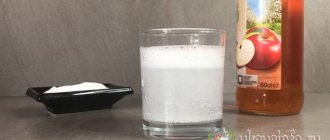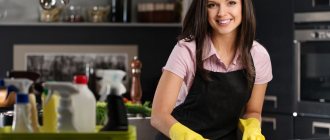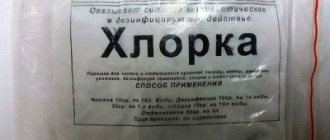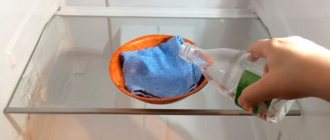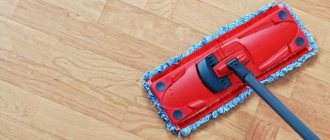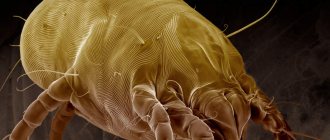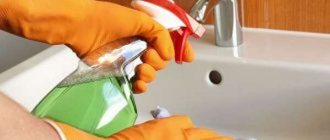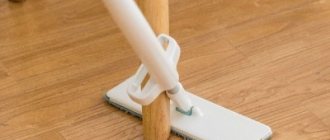Cleaning with vinegar is a proven and effective way to keep your home clean without the use of toxic chemicals.
Cleaning with vinegar is an effective way to achieve a squeaky clean home.
Tired of harmful cleaning products? Vinegar is an excellent natural cleaner.
many surfaces in the house. Surprisingly, cleaning with vinegar also helps with bad odors. After cleaning with vinegar, you just need to wipe the treated surface and the smell of vinegar will disappear, leaving behind a aroma of freshness.
The most common problems that can be treated with vinegar
Remove soap buildup and unpleasant odors from the machine by pouring a glass of white distilled (table) vinegar into the empty machine and running it through a rinse cycle. This procedure can be repeated monthly.
For a teapot, pour half a glass of white distilled vinegar and water into it and leave it overnight. If the residue still remains, then boil another half cup of white distilled vinegar in a kettle for a few minutes, let it cool and rinse with plain water.
To remove tags or price tags, attach a cloth soaked in distilled white vinegar. The fabric is left overnight, and by the morning the label can be easily removed!
You can also remove soap deposits from your bathtub or shower by wiping the surface with undiluted white distilled vinegar. Then the surface is rinsed with water.
To deodorize the toilet, pour three glasses of white distilled vinegar into the toilet and leave it for half an hour, then flush it.
To remove paint from windows, doors or glass, use hot, undiluted white distilled vinegar. Allow some time for the paint to soften, and then remove it with a razor blade.
You can wash and disinfect your child or pet using soapy water and a small amount of white distilled vinegar.
You can clean sticky scissors using a cloth soaked in white distilled vinegar.
You can do this by spraying white distilled vinegar on the bruise and then vigorously rubbing the grill with foil.
To clean and deodorize the countertop, wipe it with a cloth soaked in undiluted white distilled vinegar.
Cleaning with Vinegar: Windows and Mirrors
Many cleaning product manufacturers are starting to offer eco-friendly options for their glass cleaners, but perhaps one of the greenest options is vinegar cleaning. Use a simple solution - 2 tablespoons of vinegar per liter of water and instead of paper towels. If vinegar isn't an option for you (if you have a lot of windows to clean and you're worried the smell might be too strong), lemon juice is a good alternative.
Cleaning with Vinegar: Odors
Vinegar is great for removing bad odors from your clothes as well. Placing a cup of vinegar on your counter will quickly rid the room of unpleasant odors.
Cleaning with vinegar: dry cleaning
Cleaning clothes with vinegar is an easy and inexpensive way to deodorize clothes. Many people already know that white vinegar in a small bowl is great for removing smoke odors and musty odors, and that you can simply place a bowl of vinegar on the floor of a closet or on a shelf if your coat or jacket has become saturated with these odors. But what most people don't know is that if you add white vinegar to the water at the beginning of the wash cycle, it will refresh and soften your clothes during the wash process. The smell of vinegar will miraculously disappear before the end of the wash, and all your laundry will have a very fresh scent. You don't need a lot of vinegar - half a glass will be enough, a full glass will be too much, the exact value is not necessary. Don't forget to add your regular detergent too!
Get your plumbing sparkling clean with vinegar
Vinegar Cleaning: Plumbing
Toilet cleaners on the market today can be very toxic. Instead of these products, you can use vinegar by applying it to the surface of the toilet and leaving it for about 15 minutes. After this, you need to wash it as usual. The same mixture you used to clean your windows can also be used to shine all the china and fixtures in your bathroom. In addition, it is excellent for killing bacteria.
Vinegar Cleaning: Floors
Cleaning your floor with a solution of one cup of vinegar per liter of water will make the surface shinier.
Cleaning with Vinegar: Wood Panels
You can clean your wood paneling with a mixture of 1/4 cup, 1/2 cup vinegar and 2 cups warm water. The result will be simply amazing.
Even medieval healers knew about the bactericidal properties of vinegar. In addition, this liquid, which is a weak acid, successfully dissolves limescale. Therefore, vinegar has been used for cleaning the house for centuries. He manages to win the competition even with newfangled detergents. In this article, you will learn about cleaning methods using vinegar, as well as how to make vinegar from the essence for cleaning your home. Simple recommendations will teach you how to clean without harmful chemicals.
Valuable product from sour wine
Natural vinegar, which is rightly called food vinegar, is formed at the last stage of fermentation processes. Simply put, sweet grape or apple juice turns into wine, and then, if the fermentation process continues, the wine becomes vinegar.
Acetic acid, also known as essence, is a cheaper substitute for natural vinegar. From what components this substance is produced at chemical plants is known only to chemists. A solution of such acid is sold under the name table vinegar, but it has no nutritional value. Therefore, cleaning your home with acetic acid would be the most appropriate way to use this synthetic product. And for culinary purposes, it is better to buy natural vinegar.
How to wash flooring after renovation
Laundry soap helps to cope with many stains after repair work. The product removes dust, dirt and stains from lime and whitewash. In addition, it can quickly remove fresh traces of water-based paint. The method of application is as follows:
- Wipe the floor with a damp cloth.
- Rub problem areas with laundry soap.
- Leave for 10-20 minutes to act.
- Rinse the floor again.
The following tools will also help:
- vinegar;
- salt;
- vegetable oil;
- dishwashing liquid.
Vinegar dirt is afraid
Experienced housewives advise washing the following surfaces and objects with acetic acid:
- kitchen stove and sink;
- stainless steel dishes;
- fridge;
- plumbing items;
- window glass and mirrors;
- wall tiles;
- floor coverings.
To make cleaning your home easier with acetic acid, pour the prepared solution into a spray bottle. This will make it easier for you to spray not only flat surfaces, but also all the corners where mold is hidden.
How to make vinegar from essence for cleaning the house
Synthetic acetic acid is marketed as a 70% essence. Concentrated acid is good because it does not take up much space, and from it, as needed, you can prepare a solution of the desired strength.
To use vinegar when cleaning the house, a 5% solution is enough. The required ratio of essence and water in this case should be 1 to 14. In other words: dissolve 2 tablespoons of essence in a half-liter jar of water.
Combating lime deposits may require a stronger acetic acid solution. For example, a 15% solution will cope with deposits in the bathtub and under the toilet rim. To obtain this concentration, mix 1 tablespoon of essence with 90 ml of water.
What not to do if you have hair loss
10 “don’ts” or what is not recommended to do if you have hair loss
Human hair has long lost its biological purpose - it does not protect us from cold and wind and other negative factors. The only function that hair continues to perform is aesthetic.
Hair is of great psychological value for both men and women, and its loss becomes a severe emotional tragedy for most. It is necessary to have a good understanding of what is prohibited to do during hair loss, because incorrect behavior at this moment can affect the course of the hair loss process and lead to its aggravation.
Security measures
Keep in mind that solution concentrations above 30% may cause skin burns. If this happens, wash the burned area with water, or better yet, with a baking soda solution. Acid getting into the eye is much more dangerous. In this case, you will need the help of a doctor.
Even medieval healers knew about the bactericidal properties of vinegar. In addition, this liquid, which is a weak acid, successfully dissolves limescale. Therefore, vinegar has been used for cleaning the house for centuries. He manages to win the competition even with newfangled detergents. In this article, you will learn about cleaning methods using vinegar, as well as how to make vinegar from the essence for cleaning your home. Simple recommendations will teach you how to clean without harmful chemicals.
Valuable product from sour wine
Natural vinegar, which is rightly called food vinegar, is formed at the last stage of fermentation processes. Simply put, sweet grape or apple juice turns into wine, and then, if the fermentation process continues, the wine becomes vinegar.
Acetic acid, also known as essence, is a cheaper substitute for natural vinegar. From what components this substance is produced at chemical plants is known only to chemists. A solution of such acid is sold under the name table vinegar, but it has no nutritional value. Therefore, cleaning your home with acetic acid would be the most appropriate way to use this synthetic product. And for culinary purposes, it is better to buy natural vinegar.
Vinegar dirt is afraid
Experienced housewives advise washing the following surfaces and objects with acetic acid:
- kitchen stove and sink;
- stainless steel dishes;
- fridge;
- plumbing items;
- window glass and mirrors;
- wall tiles;
- floor coverings.
To make cleaning your home easier with acetic acid, pour the prepared solution into a spray bottle. This will make it easier for you to spray not only flat surfaces, but also all the corners where mold is hidden.
How to make vinegar from essence for cleaning the house
Synthetic acetic acid is marketed as a 70% essence. Concentrated acid is good because it does not take up much space, and from it, as needed, you can prepare a solution of the desired strength.
To use vinegar when cleaning the house, a 5% solution is enough. The required ratio of essence and water in this case should be 1 to 14. In other words: dissolve 2 tablespoons of essence in a half-liter jar of water.
Combating lime deposits may require a stronger acetic acid solution. For example, a 15% solution will cope with deposits in the bathtub and under the toilet rim. To obtain this concentration, mix 1 tablespoon of essence with 90 ml of water.
Security measures
Keep in mind that solution concentrations above 30% may cause skin burns. If this happens, wash the burned area with water, or better yet, with a baking soda solution. Acid getting into the eye is much more dangerous. In this case, you will need the help of a doctor.
Cleaning hardwood floors is a delicate job because if you don't take every precaution, you can damage the wood's surface. Here are some tips for using vinegar to clean your floors.
Finally installed the wood floors you've always wanted in your home? This is a pearl of home and apartment interiors. But almost all homeowners ask one question: “Hardwood looks stunning, but how difficult is it to maintain its appearance over time? What to do if the floors get dirty? Will I have to spend a fortune to clean the floors?
The answer to all these questions is vinegar, which will help get rid of the worst stains. Vinegar has just the perfect concentration of acetic acid (30%) that helps clean the floor without harming the wood surface, while commercial products contain substances that can harm wood floors and burn a real hole in your wallet. Vinegar helps remove grease stains, unpleasant odors, mold and other problems with wood floors. Availability and cheapness become the main advantages of vinegar, because you can almost always find it in the kitchen.
What should you not do?
Never try to get rid of stains on a freshly painted floor using simple laundry soap and hot water. This is a serious mistake that will lead to new problems:
We recommend: Modern methods of cleaning roofs from snow and ice
Vinegar is a proven household product that perfectly combines quality, productivity and affordability. When used correctly, a beautiful, sparkling floor surface and a long service life of the enamel or paint are guaranteed.
How to use vinegar to clean floors
Before you begin, you must ensure that all dust is removed. If the dust is not removed in a timely manner, the vinegar will only spread it over the entire surface of the floor, making the floor more dirty. You can use a vacuum cleaner for this purpose.
Dilute vinegar in water. The ratio is approximately one glass of vinegar to two liters of water. Do not spread this mixture directly onto the floor as it may warp the wood. Spread the mixture slowly and mop the floor with a damp mop. Next, to polish the floor and make it shine, mix equal amounts of vinegar and polish. Vinegar will help remove stains, and polish will help tidy up your floors.
Vinegar can also be used to neutralize the harmful effects of bleach. We all know that bleach, although effective, is a rather sticky substance. If you use bleach on a stain, leave it overnight and then apply vinegar to remove any remaining bleach. If the bleach is not removed, it will continue to work deeper than the stain, destroying the color and shine of the wood.
On the other hand, we could also apply vinegar directly to the stain. It takes about an hour of vinegar on the stain before you can remove the stain. But after an hour, you should wipe the stain with a damp cloth to remove any remaining acid.
You can also use vinegar as a deodorant. If there are some noticeable odors in the home, especially those associated with children, vinegar can help get rid of them. You can use undiluted white vinegar to clean hardwood floors. Make sure the area is well ventilated to ensure that both odors disappear. Remember to use a vacuum cleaner to remove dust first.
You can also clean the floors with a cloth or mop, but be careful to avoid scratching the floor surface. Also, before you start cleaning with vinegar, contact your flooring supplier for advice.
Why wash the floor with vinegar? Vinegar is a natural remedy that is used to clean and disinfect surfaces. It destroys 99% of bacteria, 90% of viruses, and 82% of mold and its spores. Vinegar cleaner is a good solvent for dirt, grease stains and soap scum, as well as an excellent odor remover. In addition, vinegar is inexpensive and available at any grocery store. Let's take a closer look at how to clean floors with vinegar.
Is it possible to wash the floor with vinegar?
Washing the floor with a vinegar solution is not only possible, but also necessary! This is the best product for cleaning flooring such as laminate, linoleum, ceramic tile and vinyl flooring. If your floors are wooden, then their surface is most often covered with protective agents: wax, oil, varnish or paint. A vinegar solution will clean most of these finishes well, but may remove the wax completely. Therefore, it is very important to know what kind of coating your floors have. If you don't know this or are simply unsure, test the cleaning solution on a small, hidden area of the floor. Also, do not wash stone floors (marble, granite, slate, sandstone, etc.) with vinegar - you can damage the surface of the stone.
Rules for choosing a disinfectant
Before you make your choice in favor of this or that product in the store, you should definitely study its composition. The ideal floor cleaning product will be one that contains less than 5% non-ionic surfactants, as well as preservatives and fragrances. This is quite enough to achieve perfectly clean floors in your home.
Half of the substances listed in many floor cleaning products have nothing to do with disinfection.
Particular attention should be paid to those products that contain sodium hypochlorite. Products similar to ordinary washing powder, and even with optical brightener, also deserve close attention. These products are not worth buying. Firstly, it will make cleaning much more difficult, and secondly, there is a risk of significantly damaging the floor covering. At best, the floor will simply stop shining.
Floor cleaning solution with vinegar
To prepare a solution for cleaning floors, dilute 1 cup of table vinegar (colorless) in 5 liters of warm water.
- To give the floor surface shine
, add a few drops of vegetable oil. Keep in mind that a thin layer of vegetable oil on the floor will gradually accumulate with each new cleaning. To remove deposits, wash the floor periodically without oil. - To reduce the pungent vinegar smell
, add a few drops of your favorite essential oil, such as lemon or lavender, to the solution. Keep in mind that the unpleasant smell of vinegar will not irritate you for long - it will disappear as soon as the floor dries. Also, be aware that some essential oils can be dangerous for pets, especially cats. - To obtain a detergent with a more neutral acid-base balance (pH)
, add 1 cup of ammonia to the solution. Vinegar is an acid (low pH) and ammonia is an alkali (high pH). By mixing them, you can create a neutral cleaner. However, this reduces the cleaning properties of such a solution, since the alkali partially neutralizes the acid. However, a neutral pH cleaner is recommended for use on some types of wood. Be careful, ammonia is a chemically hazardous substance, so always wear gloves and ventilate the area well when handling it undiluted. - To better clean a dirty floor
, add a couple of teaspoons of liquid soap to the solution. Keep in mind that cleaning products containing soap may leave unsightly marks on the floor. Therefore, if you use soap in a solution, to remove any remaining soap, wash the floor again with a solution of vinegar and water.
Stages of coating treatment in an apartment
In order to disinfect the floor in your apartment or house as quickly as possible, you should take into account some details regarding the correctness of its implementation. For example, these.
If you plan to disinfect the entire apartment at once, then in this case it should start from the outer rooms and finish with cleaning the bathroom and toilet.
Before starting cleaning, it is necessary to clear the floors in the rooms from furnishings and carpeting. For example, take out chairs, a table, ottomans, move a sofa or wardrobe into a corner.
The entire disinfection process takes place in several stages:
- Preparation of a solution for floor disinfection.
- Pre-wash the surface with a regular detergent.
- Treatment with a disinfectant solution. Usually the floors are simply sprayed with this product.
- Wet cleaning of the premises with clean water.
During such treatment, it is imperative to use rubber gloves and a gauze bandage to protect yourself.
Whatever product you choose for treating floors - industrial, natural or homemade - the disinfection process itself must be treated with extreme care.
Only by following all safety measures, the rules for preparing the solution for treatment, according to the instructions, can you ensure not only perfect cleanliness in your apartment, but also protect yourself and your household from dangerous viruses and microorganisms.
clean-up.guru
To clean floors with vinegar:
- Vacuum or sweep the floor to remove dirt and debris.
- Prepare a cleaning solution using one of the recipes above. For wood floors, use a spray bottle. Fill a bottle with a solution of vinegar and water to spray the cleaner onto the floor instead of using a mop and cloth to reduce the amount of liquid you use (too much can damage the wood surface).
- Mop the floor using a cleaning solution.
- For wood floors, wrap the mop in an old towel and wipe the floor dry.
- Do not leave wooden floors wet for long periods of time. If water soaks into the floor, the wood may warp or swell.
- Apple cider vinegar can also be used to clean floors, but it will not clean the surface as well as regular 9% table vinegar (colorless).
- If you have very hard water, add 2-3 tablespoons of baking soda for every 5 liters of detergent - this will prevent minerals from the water from depositing on the floor surface.
What mistakes do we make when faced with hair loss?
Don't panic if you're losing hair
Everyone knows the close relationship between the process of hair loss and the state of the psycho-emotional background. After all, stress is a factor causing hair loss, and it can also delay hair loss caused by other factors. The prospect of future baldness is one of the main reasons contributing to the appearance of neurosis, especially in women who naturally have thick hair. The longer the loss lasts, the greater the fear of losing the “last” hair becomes and the emphasis on the fact of loss increases. It is necessary to understand that severe and sudden forms of hair loss are most often the most favorable, most often they have a clear connection with the previous fever, disease, medication, etc., and in most cases they even go away on their own.
Don't wash your hair rarely
Washing your hair is an important hair care measure, especially during periods of active hair loss. Limiting the frequency of washing, especially the fear of washing your hair, is undesirable not only from a psychological point of view, but also from a health point of view. Sebaceous secretions that accumulate on the surface of the head during infrequent washing can cause inflammation of the skin and aggravate hair loss. On the contrary, trichologists recommend intensifying skin cleansing during periods of active hair loss - using active medical shampoos that regulate oiliness, peelings, and exfoliants.
You can’t limit combing your hair or “accumulate” falling hair.
The hair loss stage lasts 3 months - this is the period from the cessation of hair growth until the moment the hair leaves the scalp. If the hair is not combed out on time, then the dead hair will mechanically prevent the growth of “new” hair growing in its place.
You can't be in the sun without a hat
The role of negative influence of ultraviolet radiation on hair loss has been proven. The more intense the loss, the thinner the hair becomes, the greater the progression of the hair loss process.
Lost hair should not be collected or counted.
According to statistics from trichologists, collecting and counting hair that has left the head has only a negative effect on the course of hair loss. Collecting hair helps women focus on the process of hair loss, makes them neurotic, and in no case allows them to understand how much hair loss exceeds the daily norm.
